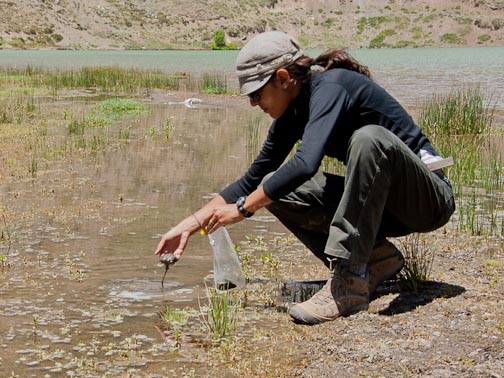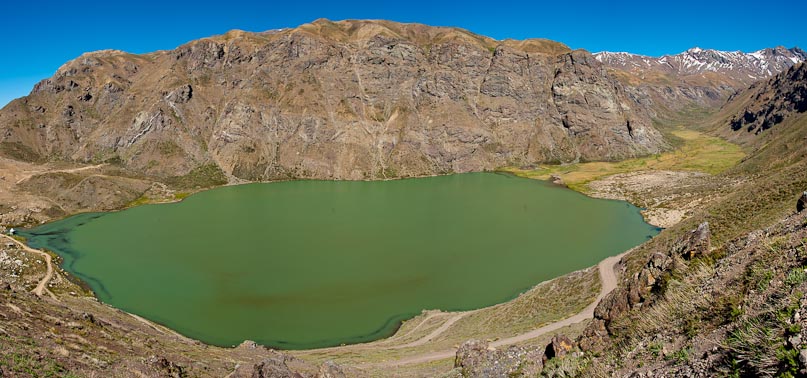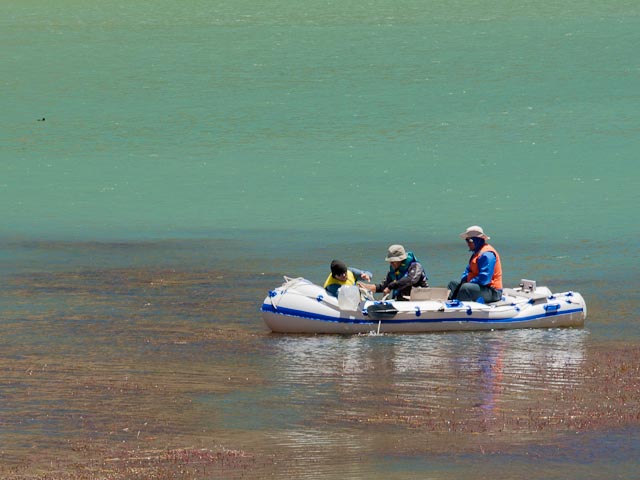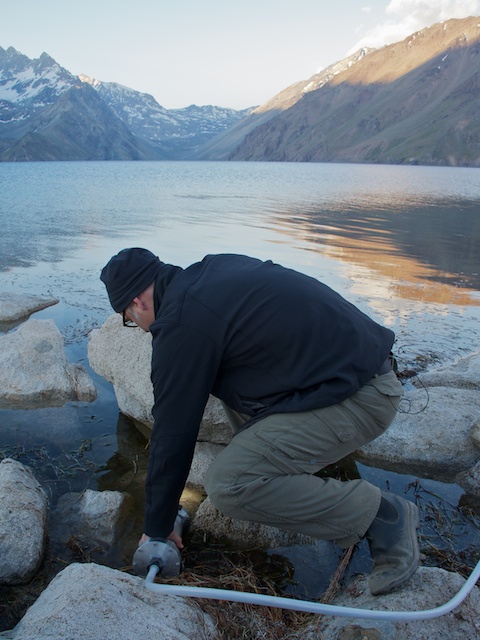Scientists Probe Undersea for Future Mission to Saturn Moon Titan

A team of scientists has traveled to remote Laguna Negra in the central Andes of Chile to test technologies that could one day be used to explore the lakes of Titan.
The Planetary Lake Lander (PLL) project is led by Principal Investigator Nathalie Cabrol of the NASA Ames Research Center and the SETI Institute, and is funded by the NASA Astrobiology Science and Technology for Exploring Planets (ASTEP) program. This three-year field campaign will design and deploy a lake lander at Laguna Negra, which is a particularly vulnerable system where ice is melting at an accelerated rate.
In addition to preparing us for Titan, the study will also help answer questions about how deglaciation affects life in glacial lakes. During the 2011 field campaign, Astrobiology Magazine's Expeditions Editor, Henry Bortman, is providing a first-hand account of the team's work through blogs and images.
Lago Lo Encañado
Thursday, December 1, 2011
The primary research site for the 2011 Planetary Lake Lander field campaign is Laguna Negra, near the shore of which the PLL base camp is located. Laguna Negra (black lagoon) is so-named because it is so clear that at times its surface appears black.
But members of the PLL science team today began their exploration of a second nearby lake, Laguna Lo Encañado (rough translation: lagoon in a canyon). Unlike Laguna Negra, Laguna Lo Encañado is opaque, sea-green in color, and lies at the end of a long valley containing significant wetlands.
Breaking space news, the latest updates on rocket launches, skywatching events and more!
Until recently, Laguna Negra spilled over into Laguna Lo Encañado, which lies 200 meters lower in elevation. But the decrease in precipitation in the region and the shrinking of the Echaurren glacier, effects of rapid climate change, have caused the water level of Laguna Negra to drop several meters in only a few years. [Photos: Stunning Lakes]
Damaging UV radiation at 8500 feet above sea level, where Laguna Negra and Laguna Lo Encañado are situated, is much higher than at lower elevations. The difference between the two lakes, turbid Laguna Lo Encañado and transparent Laguna Negra, provides a valuable point of comparison for studying the strategies organisms employ to cope with this intense radiation.
The silt that washes into Laguna Lo Encañado absorbs UV radiation. Organisms living there don’t need to work as hard as do organisms in Laguna Negra to generate protective biological sunscreen compounds. Nor do they have to put as much energy into repairing DNA damage that exposure to UV radiation can cause.
Erich Fleming and Angela Detweiler, PLL team members based at the SETI Intitute and the NASA Ames Research Center (ARC) in Moffett Field, California, study the photosynthetic microbes that live in the two lakes. These organisms are capable of producing protective compounds to mitigate the effects of UV.
Ruben Sommaruga, a professor of limnology at the University of Innsbruck, in Austria, studies the organisms that live in alpine lakes, among them small, shrimp-like crustaceans known as copepods.
Copepods obtain some of their UV-protective compounds by eating the microbes that live alongside them in the lakes. But when that doesn’t provide sufficient protection, they generate their own protection in the form of carotenoids, which turns them red. These same carotenoid compounds are found in carrots and are responsible for giving them their characteristic orange color.
Juvenile copepods – copepods go through many different stages before reaching adulthood – have not yet developed mouths, however, so they have no way to ingest protective compounds. In recent years scientists have learned that, at birth, juvenile copepods receive packages of protective compounds from their parents, to increase their chances of survival into adulthood. [11 Amazing New Species Discovered in 2011]
Incidentally, all of us at PLL Base Camp are using the lake as the source of our drinking water. Which means we’re drinking a lot of copepods. We can see them, tiny little red dots floating around in our water bottles. To protect ourselves from UV, though, we still have to slather on sunscreen.
Quote of the day: “Now we have a system.”
A Close-up Look below the Surface
Friday, December 2, 2011
One of the goals of the Planetary Lake Lander Project is to develop technology that could be applied to a future mission Saturn’s giant moon Titan.
The Titan Mare Explorer (TiME) mission, proposed by Ellen Stofan of Proxemy Research, in Rectortown, Va., would land an autonomous spacecraft on and sail across one of Titan’s methane lakes, capturing photographs and taking measurements both above and below the lake’s surface. This proposed mission is one of three funded for further design development as the next possible NASA Discovery mission.
Over the three-year course of the PLL project, engineers will develop a floating robot with capabilities similar to those that will be required by TiMe or a similar mission to Titan. [Video: Targeting Saturn's Moon Titan: Land, Sea and Air]
The Planetary Lake Lander will be able to respond autonomously to scientifically interesting events in the rapidly changing glacial-lake environment of Laguna Negra. Robotic autonomy will be important to any Titan mission because Titan is too far from Earth for scientists here to receive data from a spacecraft on Titan and to respond with real-time commands. A robot exploring one of Titan’s lakes will need to operate on its own.
But for the first year, the Planetary Lake Lander will be under human control. It will remain behind at Laguna Negra when the PLL team leaves in mid-December, deploying a package of instruments that for a three-month period will continuously monitor conditions above and below the surface of Laguna Negra, sending its data, on demand, back to engineers at NASA Ames Research Center.
Onboard the PLL during this initial 3-month stint will be a 5-megapixel camera, remotely controllable; a meteorological station to track weather conditions through the summer months; and a sonde, a package of instruments for measuring water temperature, salinity, pH and other lake-water characteristics at various depths.
Future posts will report on the deployment of the pontoon (the floating platform) and the instruments that will be installed on it. But all this was not yet in place in the early days of the PLL field season. What did get tested early on, briefly, was a microscopic underwater camera designed to give a very close-up look at what’s lurking beneath the surface of Laguna Negra.
David Wettergreen of Carnegie Mellon University in Pittsburgh, Pa., made a quick stop at the PLL base camp today to try out the camera, which lives inside a watertight metal housing. The 15-micron-per-pixel camera can see extremely small details: a single human hair appears 8 pixels wide.
The good news: the underwater test worked. The not so good news: mostly what it saw was bubbles. Not even a lonely copepod ventured by during the test. Later, however, back on shore, Wettergreen pointed the camera at a small plastic bottle filled with copepods from the lake, and beautifully detailed images of the tiny swimming crustaceans sprung to life.
The underwater camera will not be part of the instrument package deployed on the PLL at the end of the first field season, but it will be integrated into the PLL in future years.
Meanwhile, on the quality-of-life front, still no shower. Or bathroom. There are workarounds. Instead of a relaxing, warm shower, a quick jump in the freezing cold lake does wonders. For the faint of heart, pouring a bottle of water over one’s head also works. As for the bathroom, if you’ve ever gone backpacking…
Quote of the day: “Ve haf vays of making ze radios talk.”
Henry Bortman was the managing editor of Astrobiology Magazine, a NASA-sponsored website. He began his career in journalism at the Berkeley Tribe in the early 1970s and wrote for MacUser magazine until it merged with Macworld in 1997 before transitioning to science writing. He is also an avid outdoorsman, enjoying hiking, backpacking, rafting and kayaking.




